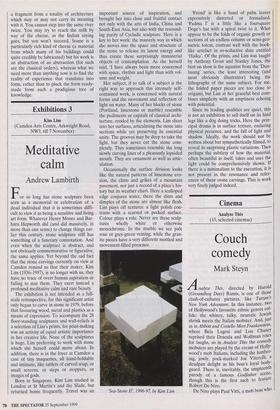Exhibitions 2
John Soane, Architect, Master of Space and Light (Royal Academy, till 3 December)
All things to all architects
Alan Powers
Few architect members of the Royal Academy have identified themselves so strongly with their institution as Sir John Soane, the architect of the late Georgian and Regency period who left us more information about himself than any other. How right, therefore, that he should be exhibited there in splendour, even though the RA exhibition galleries which he knew were those of Somerset House, designed by. Sir William Chambers, one of his principal mentors in the theory of architecture.
The design of the exhibition by Piers Gough is well calculated to show off the Joseph Michael Gandy: Public and Private Buildings. Executed by Sir John Soane, 1780-1815 models, perspective drawings and associa- tional objects which have more breathing space at Burlington House than in the Soane Museum, where some, indeed, are only seen on request. Thus, although the Museum will always remain one of the greatest posthumous self-advertisements of architecture, there is a great advantage in having a clear chronology and classification by building types which the exhibition, curated by Margaret Richardson and Mary Anne Stevens, allows. There is more to it than this, however, with a computer simu- lation of a glide (rather than a walk) through the old Bank of England, and a splendid new model of the bank, all con- tained within a full-scale mock-up of the Four Per Cent Office. The catalogue (£25) has wonderful colour reproductions and texts by a variety of hands.
I could go on piling on the hyperbole, and it would not be wrong to do so, but there is something about the way that Soane is being used as part of current architectural polemics that worries me. Some of the variety of interpretations comes across in the catalogue, with Soane being claimed as an ancestor of late Mod- ernism (by Margaret Richardson), Classical Re-Revival (by David Watkin) and Post- Modernism by different contributors. In principle, such analogies are harmless and better brought into the open, since they can otherwise influence interpretation sub- consciously and become unknoWingly objectified. Thus, Soane as Modernist has had a long career since the 1920s which depends on a partial selection of his more abstract designs, while Soane as Classicist has tended to be dismissed as rather a bore. Soane as Post-Modernist or Decon- structionist (proposed by Daniel Abramson in his study of the Bank of England) is `concerned with renovation and contingen- cy, collaboration and consultation, frag- mentation and synthesis, blurred boundaries and ambiguous expression'. Robin Middleton, writing about `Soane's Spaces and the Matter of Fragmentation', goes further in finding in Soane's interiors an equivalent of the Cubist dissolution of perspectival space, in rebellion against the thought of his time.
Soane was the inheritor of something called The Quarrel of the Ancients and the Moderns' in the 17th century, to which he added his own contribution as a theo- rist. Today, he is involved in a similar con- flict, although the Ancients (if one identifies them as current practitioners of classical architecture) are less conspicuous than they were ten or 15 years ago. The Moderns, meanwhile, are pleased to appro- priate Soane publicly, as they have often done in private, since this association defends them from any charges of histori- cal ignorance or insensitivity to the past. Not many contemporary architects borrow directly from Soane, but Richard MacCor- mac is one who is happy to own up, and is interviewed in these terms in the current number of RA Magazine.
It may seem perverse to object to con- temporary architects doing what their pre- decessors, Soane included, have always done, that is, borrow from the past. The question, perhaps, is what do they borrow from whom, and how does it benefit them? The suspicion about borrowing which came with the Modern Movement in architecture in the first decades of the 20th century was the result of a gradual exhaustion of all the symbolic languages of architecture in the course of the previous hundred years. While concerned with an attempted renew- al of symbolic language, Modernism pre- sented itself all too easily as a complete abolition of meaning, that unavoidable aspect of architecture which is now often considered too literally. There is still, how- ever, a gap between the vocabulary of architecture and the capacity of its audi- ence to understand what it is saying. Soane was as much the victim of this as anyone, since he suffered from ignorant criticism, including that of his son George. To borrow from Soane today, whether you are an Ancient or a Modern, is to snip a fragment from a totality of architecture which may or may not carry its meaning with it. You cannot step into the same river twice. You may try to reach the milk by way of the cheese, as the Indian saying goes, but you won't succeed. Soane is a particularly rich kind of cheese (a material from which many of his buildings could quite credibly be fabricated) but his work is an abstraction of an abstraction (for such are the classical orders), whereas what we need more than anything now is to find the reality of experience that translates into form, rather than to pluck the form ready- made from such a prodigious tree of knowledge.



























































































 Previous page
Previous page